F 321 – Assignment #1
Forest Measurements and Quantitative Refresher
Objective: This assignment will ask you to use quantitative approaches common to most disciplines of natural resource management. This should refresh the use of unit conversions, the relationship of triangle dimensions, and basic principles of measuring tree heights.
Student Learning Outcomes: Upon completing this assignment you will:
- Be able to convert common English and metric units used in natural resources.
- Apply trigonometric principals to solve for triangle dimensions.
- Describe common statistical symbology.
- Apply basic descriptive statistics.
- Demonstrate an understanding of tree height measurement principals.
1. Convert the following measurements as specified:
- 24 inches to millimeters
- 18 square chains to acres
- 5,000 cu ft per acre to m3 per ha
- 24,000 kg per ha to grams per m2
- 200 lbs per ac to kg per ha
- 68 ha to acres
- 4.8 km to ft
- 0.1 acres to hectares
- 563 m3 per ha to cubic feet per acre
- 23 square miles to km2
2. Write these numbers in scientific notation:
- 4260
- 38400
- 0258
- 005454
3. Fill in the missing values in each of the below tables, using the associated triangle for reference:

4. Define the following statistical symbols:
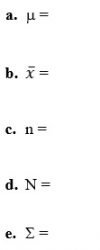
5. Calculate the mean, median, mode, range, and standard deviation of the tree heights and DBH collected from a 1/10th acre monitoring plot on the Manitou Experimental Forest. Create a histrogram for both datasets and describe their distributions, this will require you to select an approapriate bin size.

6. What would be the percent scale reading for a slope of 45°?
7. Refer to the figure on the right and calculate the total height to the nearest foot for each of the following tree measurement scenarios (each of these assumes a reading of 0 to B):
- You are standing at a horizontal distance of 100 feet and your percent scale reads 50 to A and -10 to C.
- You are standing at a horizontal distance of 50 feet and your percent scale reads 40 to A and -10 to C.
- You are standing at a horizontal distance of 66 feet and your topographic scale reads 50 to A and -10 to C.
- You are standing at a horizontal distance of 200 feet and your percent scale reads 50 to A and -20 to C.
- You are standing at a horizontal distance of 100 feet and your percent scale reads 45 to A and -10 to C.
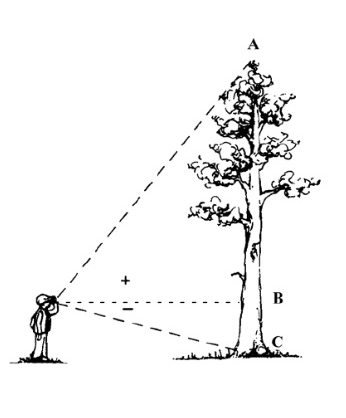
8. Correcting for the slope distance, calculate the total tree height, crown length, and % live crown. (measurements with the topographic scale)
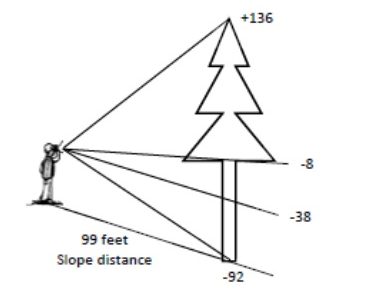
9. Refer to the figure on the right and calculate the total height to the nearest foot from each of the following trees:
- AB is measured as 140 feet and BC as 35 feet.
- AB is measured as 170 feet and BC as 65 feet.
- AB is measured as 35 meters and BC as 20 meters.
- AB is measured as 170 feet and BC as 15 meters.
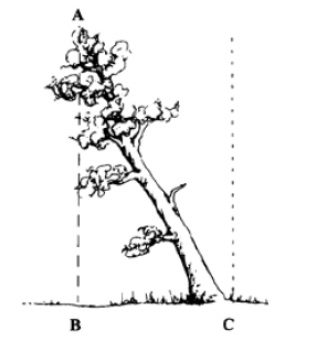
10. Use trigonometry to calculate the total height to the nearest foot from each of the following trees:
- You are standing at a horizontal distance of 100 feet. Your sighting to base = -5°. Your sighting to top = +45°.
- You are standing at a horizontal distance of 66 feet. Your sighting to base = +10°. Your sighting to top = +60°.
- You are standing at a horizontal distance of 30 meters. Your sighting to base = -3°. Your sighting to top = +58°.
11. What is the crown ratio of the tree shown to the right?
Hypsometer readings are expressed in percent units.
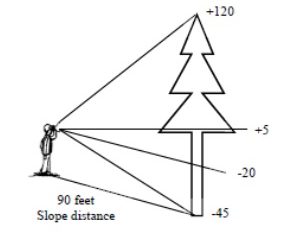
12. What is the horizontal distance and height of the following trees? (Use of a cheat sheet will receive no credit)
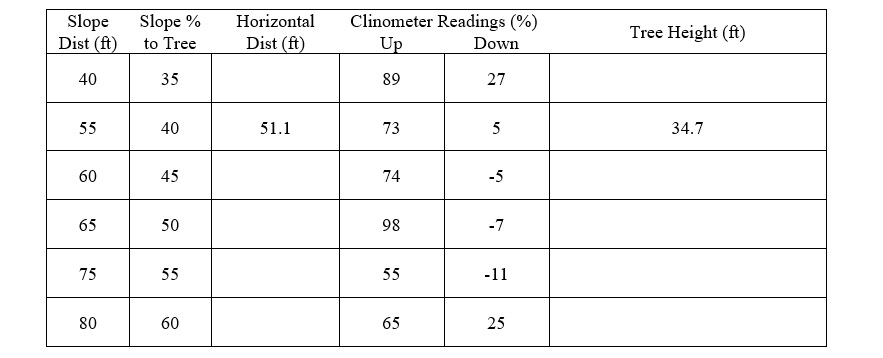
13. What crown class classifications would you give for each of the following conifer trees? Explain any assumptions:

Extra Credit (5 points):
Describe, with the aid of a diagram, how without using instruments you might determine the height of a tree from its shadow length (Be specific).
